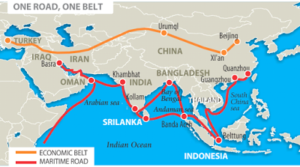
The inaugural Belt and Road Summit was organized on May 18, 2016 under the theme of “Navigating a World of New Opportunities through Hong Kong” by the government of Hong Kong special Administrative Region, supported by the Ministry of Foreign Affairs, the National Development and Reform Commission, the Ministry of Commerce and the People’s Bank of China assisted by the Hong Kong Trade Development Council. China will be holding the second One Belt and One Road (OBOR) Summit in Beijing on May 14-15, 2017 to come up with interconnected development plans. Hence it would be China’s most important diplomatic event of the year. It would provide a visionary blueprint for global economic development in the new world order. As China’s dynamic leader Xi Jinping put forward the Belt and Road Initiative in 2013, with the objective of building a trade and infrastructure network connecting Asia with Europe and Africa along the ancient Silk Road trade routes. Since then more than 100 countries and international organizations gave pleasant responses to the initiative. The routes include more than 60 countries and territories from Asia to Europe via Southeast Asia, South Asia, Central Asia, West Asia and the Middle East.
Being the first link into OBOR (One Belt One Road) initiative, the CPEC (China–Pakistan Economic Corridor) contains tremendous significance promising China access to the India Ocean from the east and west of India. So it is pertinent to discuss here that what kind of promises this upcoming summit would bring for the CPEC project; either good news or ambiguities? As CPEC vision includes the integrated transport& IT systems roads, rail, port, air and communication channels, energy cooperation, spatial layout, functional zones, industries and industrial parks, agricultural development & poverty alleviation, tourism cooperation and people to people communication, cooperation in livelihood areas, financial cooperation and human resource development. Up till now what has been delivered on the ground under this joint venture and what is the remaining part, the gap should be taken into account precariously to manage the perceptions of negative minds by giving correct and transparent information.
The Project Director of CPEC project, Mr. Hassan Daud Butt exposing/revealing the current status of the CPEC said that the project is entering the industrialization phase and nine economic zones have been identified to be set up in different parts of countries. By 2018 7000 MW of energy would be added to the national grid, and eastern and western routes will be completed by December 2018 and July 2018 respectively. As the short and medium term project under the CPEC is being pursued, the long-term plans are yet to be finalized in this upcoming summit which contains overall ideas, track and goals of cooperation till 2030. Pakistan has shared the draft of long-term plans with the China’s National Development and Reform Commission for the approval and signing during this summit. Mr. Butt said that Pakistan is hopeful and expecting good news coming from the summit and both states would soon conclude an agreement for the financing and the construction of Gwadar International Airport.
CPEC has very robust, bilateral, political, economic social basis following the trends of economic globalization as per the need of time. It promises a massive development and with China’s creative diplomacy, this century would be the Asian century. Is it a credit? What is the payback time of credit? What would happen if any default occurs? These questions need to be addressed/asked by Pakistan in the upcoming summit. A flood of lending to a smaller country lack strong foreign exchange reserves might not be able to repay the loans if projects fail to generate revenues as expected?
This summit would provide Pakistan with a platform to show its concerns regarding the whole measure of investment of the CPEC project. As CPEC is a grand vision/strategy, would take a decade but there is no measurement of the total investment. So Pakistan’s concerns should be addressed regarding total investment in long-term plans which will be featured in the forthcoming event/summit.
As the CPEC came into being from a proposed initiative to strategy, from a concept to a concrete project Likewise, Pakistan is optimistic regarding the finalization of long-term plans of CPEC in the OBOR summit. The great news is expected to be heard during the summit. Pakistan has great opportunity to interact with other participating countries to make more inclusive and open the CPEC project. PM Nawaz Sharif will be being paid the prominent standing at the summit. He will address the high-level dialogue and both the roundtables. There are 29 heads of state and government, representative of 61 international organizations and delegates from 110 countries, the secretary-general of UN, the president of World Bank and the International Monetary Fund will be at the OBOR Summit. This would provide an opportunity to the Pakistani delegation to interact with relevant leaders to enhance diplomatic and business bonds. This is pertinent to discuss here that Pakistan should discuss all the security concerns and anti-CPEC sentiments emerging from the rival countries along with the deadlines for the future projects because security aspect is very crucial and how the negative propaganda should be managed through the perception management methods. The collaborative efforts should be taken into account to scuttle the anti-CPEC efforts/sentiments.
